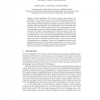Free Online Productivity Tools
i2Speak
i2Symbol
i2OCR
iTex2Img
iWeb2Print
iWeb2Shot
i2Type
iPdf2Split
iPdf2Merge
i2Bopomofo
i2Arabic
i2Style
i2Image
i2PDF
iLatex2Rtf
Sci2ools
99
Voted
TACAS
2010
Springer
2010
Springer
Blocked Clause Elimination
Boolean satisfiability (SAT) and its extensions are becoming a core technology for the analysis of systems. The SAT-based approach divides into three steps: encoding, preprocessing, and search. It is often argued that by encoding arbitrary Boolean formulas in conjunctive normal form (CNF), structural properties of the original problem are not reflected in the CNF. This should result in the fact that CNF-level preprocessing and SAT solver techniques have an inherent disadvantage compared to related techniques applicable on the level of more structural SAT instance representations such as Boolean circuits. In this work we study the effect of a CNF-level simplification technique called blocked clause elimination (BCE). We show that BCE is surprisingly effective both in theory and in practice on CNFs resulting from a standard CNF encoding for circuits: without explicit knowledge of the underlying circuit structure, it achieves the same level of simplification as a combination of circui...
Related Content
| Added | 14 May 2010 |
| Updated | 14 May 2010 |
| Type | Conference |
| Year | 2010 |
| Where | TACAS |
| Authors | Matti Järvisalo, Armin Biere, Marijn Heule |
Comments (0)

